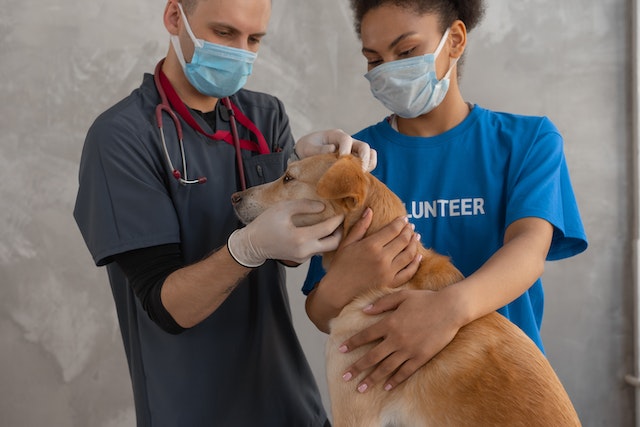11 Potential Causes of Ear Infections in Dogs

Today, we’re diving into a topic that all furry friends can relate to – the causes of ear infections in dogs.
From the itchy ears to the head tilts, these infections can be a major pain for our canine companions.
But fear not, because, in this blog post, we’ll uncover the common causes behind these pesky infections and how you can prevent them.
Let’s get started…
Signs of Ear Infections in Dogs
Ear infections in dogs can be identified through several signs. These include excessive scratching or rubbing of the ears, redness or swelling of the ear canal, and a strong odor coming from the ears.
If your dog displays any of these symptoms, it is important to consult a veterinarian for a proper diagnosis and treatment.
Read more about symptoms of ear infection in dogs.
Causes of Ear Infections in Dogs
Ear infections in dogs can be caused by a variety of factors including allergies, such as food or environmental allergies, which can lead to inflammation and increased susceptibility to infections.
Other causes can include excessive moisture in the ears, ear mites, foreign objects in the ear, or underlying health conditions that weaken the immune system.
Let’s dive deeper…
The following are some of the most common causes of ear infections in dogs:
1. Breed Predisposition
Breed predisposition refers to the increased likelihood of certain dog breeds developing specific health conditions or diseases, including ear infections. This occurs due to the anatomical differences and genetic factors unique to each breed.
Dogs with floppy ears, such as Cocker Spaniels or Basset Hounds, are more prone to ear infections due to reduced airflow and increased moisture in the ear canal.
To prevent ear infections, regular ear cleaning and maintenance should be implemented, especially for susceptible breeds.
Treatments for ear infections in dogs include proper diagnosis by a veterinarian, appropriate medication, and in severe cases, surgical intervention may be required.
2. Excessive Moisture from Bathing or Swimming
Excessive moisture in dog ears from bathing or swimming can cause ear infections in dogs.
When water gets trapped in the ear canal, it creates a damp environment that promotes the growth of bacteria and yeast.
To prevent this, it is important to dry your dog’s ears thoroughly after bathing or swimming using a clean towel or cotton balls.
Additionally, keeping the ear hair trimmed can help air circulation and prevent moisture buildup.
If an ear infection occurs, it is crucial to consult a veterinarian for appropriate treatment, which may include ear cleaning, medication, and addressing any underlying causes.
3. Allergies
Pollen or food allergies are a common cause of ear infections in dogs. When a dog is allergic to pollen or certain foods, their immune system overreacts, leading to inflammation in the body, including the ears.
This inflammation can create a favorable environment for bacteria or yeast to grow, causing an ear infection.
To prevent allergies from causing ear infections, it is essential to identify and avoid the allergens triggering the reaction. Regular cleaning of the dog’s ears and maintaining good hygiene can also help prevent infections.
Treatment options for ear infections caused by allergies may include topical medications, such as ear drops or creams, to reduce inflammation and fight off any infection present.
In severe cases, oral medications or allergy shots may be recommended by a veterinarian.
4. Ear Mites
Ear mites, scientifically known as Otodectes cynotis, are a common cause of ear infections in dogs.
These tiny parasites infest the ear canal, causing irritation, inflammation, and secondary bacterial or yeast infections.
Ear mites are highly contagious and can be transmitted from one dog to another through close contact.
To prevent ear mites, regular ear cleaning is essential, especially for dogs that are prone to ear infections. Using a veterinarian-approved ear cleaner, gently wipe the inside of the ear to remove dirt and debris.
Additionally, maintaining good hygiene and avoiding contact with infested animals can reduce the risk of infection.
Treatment for ear mites involves the use of prescription medications, such as ear drops or topical creams, to kill the mites. These medications often contain insecticides or acaricides that target the parasites.
It is crucial to follow the instructions provided by the veterinarian and complete the entire treatment course to eliminate the mites effectively.
Regular check-ups with a veterinarian are important for early detection and prompt treatment of ear mites or any other ear infections in dogs. The vet can perform a thorough examination, diagnose the cause of the infection, and recommend appropriate treatment options for the dog’s specific condition.
Read more about how to deal with ear mites in dogs.
5. Earwax Buildup
Earwax buildup can be a cause of ear infections in dogs. This occurs when excessive wax accumulates in the ear canal, creating a favorable environment for bacteria and yeast to grow.
Regular ear cleaning can help prevent this buildup by removing excess wax and debris.
Treatment for earwax buildup and infections typically involves cleaning the ears with a veterinarian-recommended solution and, if necessary, administering medications such as ear drops or antibiotics.
6. Excess Hair in the Ear Canal
Excess hair in the ear canal can contribute to ear infections in dogs. This occurs when the hair blocks the ear canal, limiting airflow and creating a warm, moist environment ideal for bacterial or yeast overgrowth.
To prevent this, regular grooming and cleaning of the ears is essential. Trimming the excessive hair in the ear canal helps to maintain proper ventilation and reduce the risk of infection.
Treatment typically involves a thorough cleaning of the ear canal, followed by medication prescribed by a veterinarian to address any infection present.
Regular monitoring and preventive measures can help keep dogs’ ears healthy and reduce the occurrence of ear infections.
7. Bacteria
Excessive Bacteria growth in dog ears is a common cause of ear infections in dogs. These infections typically occur when certain types of bacteria, such as Staphylococcus or Pseudomonas, enter the dog’s ear canal.
This can happen due to factors like moisture buildup, allergies, or foreign objects in the ear.
To prevent bacterial ear infections, it is important to regularly clean and dry your dog’s ears, especially after swimming or bathing.
Treatment usually involves the use of prescribed antibiotics and ear drops, which should be administered as directed by a veterinarian.
In some cases, the veterinarian may also recommend additional measures like ear flushes or dietary changes to promote overall ear health in dogs.
8. Yeast
Yeast can be a common cause of ear infections in dogs. It occurs when there is an overgrowth of yeast, typically Malassezia, in the ear canal.
This overgrowth can be triggered by factors such as allergies, moisture, or a weakened immune system. To prevent yeast ear infections, it’s important to keep your dog’s ears clean and dry, especially after swimming or baths.
Treatment typically involves cleaning the ears with a veterinarian-recommended solution and applying an antifungal medication, which may be in the form of drops or ointment.
9. Poor Ear Hygiene
Poor ear hygiene can be a significant cause of ear infections in dogs. When dogs’ ears are not properly cleaned and maintained, it creates an environment that is conducive to the growth of bacteria, yeast, and other microorganisms.
This can lead to inflammation, itching, and ultimately, ear infections. To prevent this, regular cleaning of the ears using a veterinarian-recommended ear cleaner is essential.
It is also crucial to keep the ears dry after bathing or swimming. In terms of treatment, veterinarians may prescribe ear drops or medications to address the infection, along with recommendations for ongoing ear care to prevent future infections.
10. Hormonal Imbalances
Hormonal imbalances can contribute to ear infections in dogs. One common hormonal imbalance that can affect the ears is hypothyroidism, which leads to decreased immune function and increased susceptibility to infections.
Another hormonal imbalance, such as Cushing’s disease, can cause excessive production of cortisol, leading to a weakened immune system.
To prevent hormonal imbalances, regular veterinary check-ups, balanced diets, and proper grooming are essential.
Treatment for hormonal imbalances causing ear infections may involve hormone replacement therapy or medication to manage the underlying condition.
Additionally, maintaining good ear hygiene and addressing any concurrent infections or allergies is crucial for successful treatment.
11. Trauma
Trauma can be a cause of ear infections in dogs. When a dog experiences trauma to the ear, it can disrupt the normal protective mechanisms of the ear canal, making it more susceptible to infections.
Trauma can occur from activities like excessive scratching, head shaking, or foreign objects entering the ear.
To prevent trauma-related ear infections, it is important to regularly inspect and clean your dog’s ears, avoid excessive force when grooming, and keep their environment free from potential hazards.
The treatment for trauma-related ear infections in dogs usually involves cleaning the ear, administering appropriate medication, and addressing the underlying cause of the trauma, if possible.
Maintaining a Healthy Ear in Dogs
Maintaining a healthy ear in dogs is important to prevent ear infections and discomfort.
Here are some tips for keeping your dog’s ears healthy:
- Regular Cleaning: Clean your dog’s ears regularly to remove dirt, debris, and excess wax. Use a veterinarian-recommended ear cleaning solution and gently wipe the outer part of the ear with a cotton ball or a soft cloth.
- Avoid Overcleaning: While regular cleaning is important, overcleaning can disrupt the natural balance in the ear and lead to irritation. Clean your dog’s ears only as needed or as recommended by your veterinarian.
- Inspect for Redness or Odor: Regularly inspect your dog’s ears for any signs of redness, swelling, discharge, or foul odor. These can indicate an ear infection or other ear issues, and prompt veterinary attention may be needed.
- Avoid Moisture Buildup: Moisture in the ears can create a favorable environment for bacteria and yeast. After bathing or swimming, make sure to dry your dog’s ears thoroughly. You can use a clean towel or a hairdryer on a low setting.
- Trim Excess Hair: Dogs with long, floppy ears or excessive hair around the ear canal are more prone to ear problems. Regularly trim the hair around the ear to improve airflow and reduce the risk of moisture and debris buildup.
- Avoid Ear Irritants: Keep your dog away from irritants such as chemicals, allergens, and excessive dust. These can cause inflammation and increase the likelihood of ear issues. Be cautious when using ear drops or any other products in your dog’s ears, and consult with your veterinarian if needed.
- Prevent Foreign Objects: Dogs may sometimes get foreign objects, such as grass seeds or foxtails, stuck in their ears. Regularly check your dog’s ears for any signs of foreign objects and remove them carefully. If you’re unsure or if the object is deeply lodged, consult your veterinarian.
- Regular Veterinary Check-ups: Schedule regular check-ups with your veterinarian to have your dog’s ears examined. Your vet can detect any early signs of ear problems and provide appropriate treatment or preventive measures.
- Know Your Dog’s Breed: Some dog breeds are more prone to ear issues, such as those with long, floppy ears. Research about your dog’s breed and its specific ear care needs. This can help you understand the potential risks and take appropriate preventive measures.
Remember, if you notice any signs of ear problems or have concerns about your dog’s ears, it’s always best to consult with your veterinarian for proper diagnosis and treatment.
Read more about cleaning your dog ears.
Frequently Asked Questions
What are the common causes of ear infections in dogs?
Ear infections in dogs can be caused by various factors, including allergies, bacteria or yeast overgrowth, excessive moisture or humidity, foreign objects in the ear canal, hormonal imbalances, or even certain breeds with floppy ears that trap moisture.
Can certain allergies lead to ear infections in dogs?
Yes, allergies can contribute to ear infections in dogs. Environmental allergens like pollen, dust mites, or mold, as well as food allergies, can cause inflammation in the dog’s ears, making them more susceptible to infection.
How does excessive moisture or humidity contribute to ear infections?
Excessive moisture or humidity creates a favorable environment for bacteria or yeast to thrive in a dog’s ear canal. This can occur from swimming, bathing, or even excessive wax production, leading to an increased risk of ear infections.
Are certain dog breeds more prone to ear infections?
Yes, some dog breeds are more prone to ear infections due to their ear anatomy. Dogs with floppy or hairy ears, such as Cocker Spaniels or Poodles, have a higher likelihood of trapping moisture and debris, making them more susceptible to infections.
Read more about deafness in dogs and the causes of deafness.
Can hormonal imbalances contribute to ear infections in dogs?
Yes, hormonal imbalances, specifically an underactive thyroid or Cushing’s disease, can weaken a dog’s immune system and make them more susceptible to ear infections. These conditions should be addressed by a veterinarian.
How can I prevent ear infections in my dog?
Regular ear cleaning, proper grooming, and keeping your dog’s ears dry are essential in preventing ear infections. Avoid using harsh chemicals or excessive cleaning, as this can disrupt the natural balance of the ear. Consult your veterinarian for specific prevention strategies based on your dog’s breed and individual needs.
How do dogs get ear infections?
Dogs can get ear infections through various causes, such as allergies, foreign objects in the ear, excessive moisture, or underlying health conditions. These factors can lead to the growth of bacteria or yeast in the ear, resulting in inflammation and infection. Regular cleaning and proper ear care can help prevent ear infections in dogs.
Read more about common ear problems in dogs
Conclusion
In conclusion, ear infections in dogs can be caused by a variety of factors. From allergies to foreign objects, understanding the root cause is crucial for effective treatment. Remember, a happy pup starts with healthy ears.


![Head Trauma in Dogs [Signs, Causes & Treatment] Head Trauma in Dogs](https://petcreeks.com/wp-content/uploads/2023/12/pexels-mikhail-nilov-7469230.jpg)



